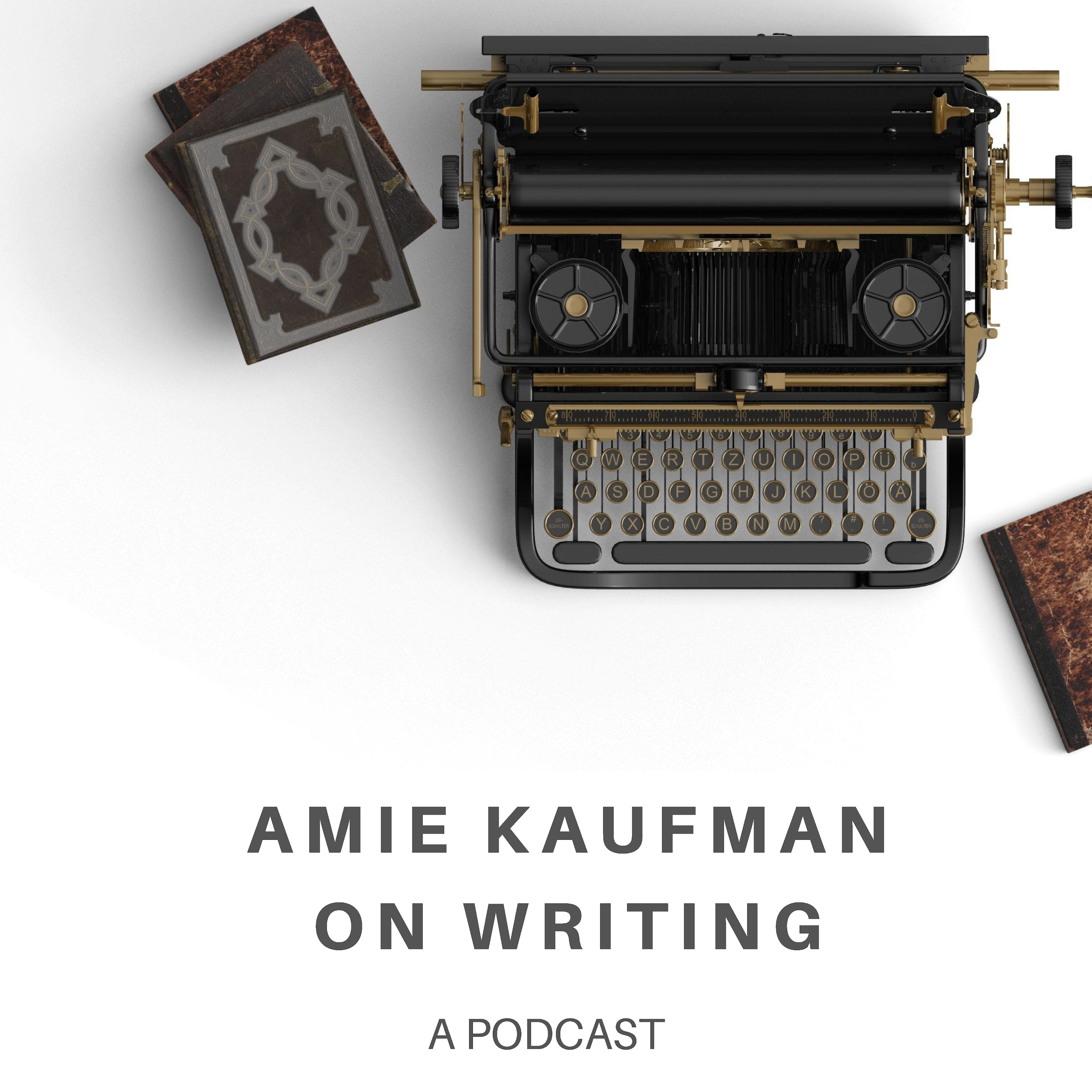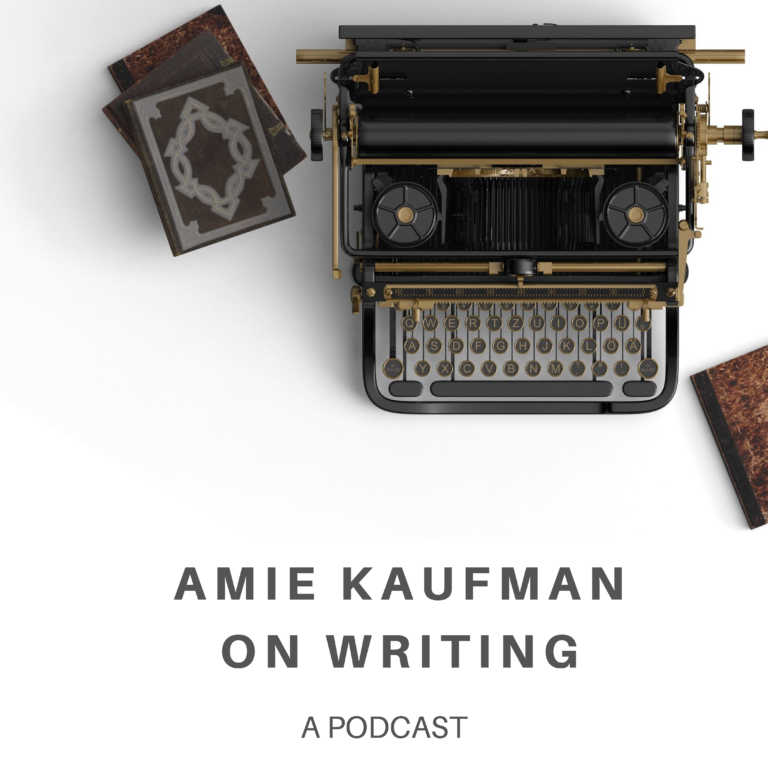Episode 5: Writing Genuinely Evil Villains

New York Times and internationally bestselling author Amie Kaufman answers one question each week about writing craft. Full of practical tips and an exercise each week, this is a show for writers, for readers who want a backstage look at how their favourite authors craft their stories, or for creative writing classrooms.
You can find a transcript of this episode at my website, where you can also subscribe to my newsletter, get behind-the-scenes peeks at how I write, and any other news about new books, events or the podcast. You can also submit a question for the podcast on my website. You can find me on Twitter or Instagram.

FOLLOW ON APPLE PODCASTS . FOLLOW ON SPOTIFY . FOLLOW ON OVERCAST . FOLLOW ON PODCAST ADDICT
Season 2, Episode 5: Writing Genuinely Evil Villains
Hi, my friends.
Welcome to Amie Kaufman on Writing, a short podcast that answers one question each week about how writers do what they do.
If you’re a writer, or you’re a reader interested in how your favourite authors craft their stories, then you’re in the right place.
This is Season 2, Episode 5: Writing Villains
Here’s my friend and producer Kate with this week’s question. Hi Kate, how are you?
Hi Amie, I’m good!
This week’s question is from Louie, who says: How do I create an interesting antagonist who’s genuinely a bad person – cruel, or evil – but is also intriguing to the reader?
I loved this question, because I love writing villains. There are so many ways you can go about it, and in future episodes we’ll talk about writing sympathetic, or misunderstood villains, but today’s all about a baddie who’s just that – genuinely awful.
Villains play so many different parts in making your story work. They help drive the plot forward, they reveal so much about your protagonist, and they raise the stakes over and over.
You may have heard advice in the past that I certainly follow – that a really strong, three-dimensional villain is someone who believes they’re the hero of the story. They’ve got genuine motivations for the things they do, beyond just wanting to twirl their moustache and laugh an evil laugh.
That advice holds here, too. Even if everything the villain believes is anathema to the hero, the villain needs to be complex, if they’re going to engage the reader.
Here are four tips for writing genuinely bad villains who’ll hook your reader. Remember, you don’t need to pack all of these in – and that’s always true with the tips I give you. Think of them as a toolbox you can reach into, whether you’re creating your villain at the start of your writing, or diagnosing issues during edits.
Tip one: Make them competent. We like people who are good at what they do – it’s an admirable quality, and it helps immediately draw the reader into the villain’s orbit. The villain’s competency also means that the hero’s ultimate victory is all the more impressive and satisfying.
When the villain is competent, that also raises the stakes. It means they can serve up proper setbacks to the hero—it means that we genuinely don’t know how things are going to end, because this opponent isn’t one who can be easily defeated.
Although we might hope and believe that ultimately the hero will triumph, our questions about how they can possibly do it in the face of such a dangerously competent villain create exactly the intrigue we’re looking for. Readers will keep turning pages, because they want the answers. Think of Moriarty and Sherlock – Moriarty’s fearsome intelligence really does throw the outcome into doubt at times, and that’s hard to turn away from.
Here’s tip two: Make your villain powerful. This is something you can do in many ways. You can make them intelligent and expert at what they do – that’s the competence tip we just discussed – or you can give them a giant ray gun they can use with impunity, or you can give them authority over the hero – make them a powerful person in the hero’s life.
Their power should be able to affect the hero’s life – maybe they’re a monarch, or captain of the hero’s battalion. Think of Dolores Umbridge’s power to impact Harry Potter – she’s the head of the school, and there’s nothing he can do to change that. Or think of President Snow, and the power he wields over Katniss and everyone in her society.
There’s something terrifying about a villain who can affect your life in ways you can’t prevent, and if you’re looking for ways to intrigue your reader, then the twin questions of whether the hero can defeat someone so powerful, and just how satisfying that justice would be will generally do the trick.
On to tip three: Let’s talk relationship arcs. We’re all used to thinking about the hero’s relationship arc with their love interest, or their companions on their quest, or their workmates or classmates. It’s worth considering whether your hero should have one with the villain, as well.
There’s definitely terror to be found in a villain who’s totally impersonal, but introducing a relationship between hero and villain can work very effectively as well.
After all, if the villain is the hero of their own story, then the hero is… that’s right, the villain of the villain’s story.
The two of them should have goals that contradict each other, so that a victory for one means a setback or a defeat for the other. And the more personal their involvement – whether they know each other from the start, or whether they encounter each other as the story goes on, and then slowly begin to react to each other – the harder their clashes will hit both the hero and the reader.
Giving your villain moments of vulnerability doesn’t mean we have to compromise on them being a genuinely evil person – but it might mean we care more about what happens to them.
And finally, tip four: Your villain’s actions need to make sense. I mean, sure, some people just want to watch the world burn, but random actions with no apparent motivation quickly become frustrating for readers. It’s also hard to build a compelling plot around them.
Our villain needs a moral code, a set of rules, or a reason for doing as they do – even if it’s one we can’t stand.
For an example here, we can look to someone like Hannibal Lecter. Now, I had to read The Silence of the Lambs for one of my university subjects, and it scared the pants off me. It’s not the sort of thing I voluntarily read.
I ended up with all the lights on, huddled in one corner of my bed, jumping at the smallest sound. One thing that was clear was that Hannibal Lecter has a very personal moral code – you might not agree with it, but he’s specific and consistent about how his decisions are made. That relentless application of his principles is one of the things that’s so scary about him – you can’t appeal to him to make an exception
But though we fear what he does, we understand why it’s happening—and when a reader’s wondering what can possibly happen to move this immoveable object, or whether it can be done at all, you’ve made a good start on intriguing them.
So, those are four places to start when you want to write a villain who’s genuinely a bad person, and you want to make sure they intrigue your reader:
- Make them highly competent.
- Make them powerful in the hero’s life.
- Give them a relationship arc with the hero.
- Give them a (probably quite twisted) moral compass.
Here’s an exercise: Think about someone you consider a villain – it could be a character from a book or movie, or a public figure in real life. You’re looking for someone you don’t like, but someone you’re interested in. Ask which of these four categories they fall into – it’s probably more than one – and why. Maybe it’s information you can use to inform the next villain you write, or figure out why you’re so drawn to the next truly bad villain that you read.
That’s all for this week. Next week, I’ll be answering a question about how make sure a cast of characters all have distinctive voices.
In the meantime, I’ll remind you to subscribe, and leave the podcast a review wherever you listen. Both these things help new listeners find the podcast, and I really appreciate it.
You can find me at my website, which is at amiekaufman.com – you can subscribe to my newsletter there, for behind-the-scenes peeks at how I write, and any other news about new books, events or the podcast. You can also submit a question for the podcast on my website. You can find me on instagram at @AmieKaufmanAuthor or on twitter at @AmieKaufman. This podcast is produced by the lovely Kate Armstrong, host of one of my favourite podcasts, The Exploress, which time travels through women’s history one era at a time. You can find her at theexploresspodcast.com.
For now, thanks so much for listening – enjoy your reading, and enjoy your writing.
Have a Question?
You can submit your question using the form using the form on the main podcast page — if you’re stuck on one aspect of your work, or you’re wondering how your favourite author pulled something off, we’d love to hear from you!
